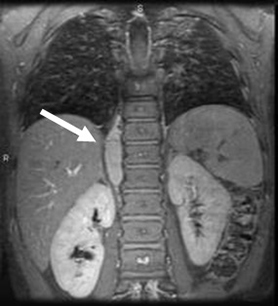Summary
Definition
History and exam
Key diagnostic factors
- presence of risk factors
- age ≤4 years
- abdominal distention
- abdominal mass
- pain
- decreased appetite
- weight loss
- fussiness (infants)
- fatigue
- periorbital ecchymosis (panda eyes)
- subcutaneous skin nodules
- family history of neuroblastic tumours
- signs of spinal cord compression
- signs of Horner syndrome
- signs of superior vena cava syndrome
- intractable secretory diarrhoea
- opsoclonus-myoclonus ataxia (OMA)
Risk factors
- neurocristopathies or other syndromes
- family history of neuroblastic tumours or genetic predisposition
Diagnostic investigations
1st investigations to order
- FBC
- serum electrolytes
- serum creatinine/urea
- LFTs
- urine catecholamines
- ultrasound abdomen
- CT scan
- MRI scan
- tumour biopsy
Investigations to consider
- bilateral bone marrow aspiration and biopsy
- molecular genetic testing
- serum LDH
- serum vasoactive intestinal peptide (VIP)
- 123-iodine-metaiodobenzylguanidine (MIBG) scintigraphy
- positron emission tomography with 18-F-deoxyglucose (18F-FDG PET)
Treatment algorithm
Contributors
Authors
Jason Shohet, MD, PhD
Associate Professor
University of Massachusetts
Chan Medical School
Worcester
MA
Disclosures
JS is an author of a reference cited in the topic.
Jennifer Foster, MD, MPH
Clinical Director, Neuroblastoma Program
Associate Professor
Department of Pediatrics Section of Hematology/Oncology
Texas Children's Cancer Center
Baylor College of Medicine
Houston
TX
Disclosures
JF has served on the advisory board for US WorldMeds. JF is an author of references cited in the topic.
Peer reviewers
Juliet C Gray, MB, BS, MA, MRCPCH, PhD
Associate Professor and Consultant in Paediatric Oncology
University of Southampton
Southampton
UK
Disclosures
JCG declares that she has no competing interests.
Daniel Weiser, MD
Medical Director, Intra-Abdominal Solid Tumor Program
Children's Hospital at Montefiore
Assistant Professor, Departments of Pediatrics & Genetics
Albert Einstein College of Medicine
Bronx
NY
Disclosures
DW declares that he has no competing interests.
Keri A. Streby, MD
Assistant Professor of Pediatrics
Nationwide Children's Hospital
The Ohio State University
Columbus
OH
Disclosures
KS is a consultant for YmAbs Therapeutics, Inc, Amgen, and Illumina Radiopharmaceuticals, Inc.
David Ziegler, MBBS, BSc (Med), FRACP, MD/PhD
Senior Staff Specialist
Sydney Children’s Hospital
Randwick
Sydney
Australia
Disclosures
DZ declares that he has no competing interests.
Peer reviewer acknowledgements
BMJ Best Practice topics are updated on a rolling basis in line with developments in evidence and guidance. The peer reviewers listed here have reviewed the content at least once during the history of the topic.
Disclosures
Peer reviewer affiliations and disclosures pertain to the time of the review.
References
Key articles
Brisse HJ, McCarville MB, Granata C, et al. Guidelines for imaging and staging of neuroblastic tumors: consensus report from the International Neuroblastoma Risk Group Project. Radiology. 2011 Oct;261(1):243-57.Full text Abstract
National Comprehensive Cancer Network. NCCN clinical practice guidelines in oncology: neuroblastoma [internet publication].Full text
Park JR, Bagatell R, Cohn SL, et al. Revisions to the International Neuroblastoma Response Criteria: a consensus statement from the National Cancer Institute Clinical Trials Planning Meeting. J Clin Oncol. 2017 Aug 1;35(22):2580-7.Full text Abstract
Irwin MS, Naranjo A, Zhang FF, et al. Revised neuroblastoma risk classification system: a report from the Children's Oncology Group. J Clin Oncol. 2021 Oct 10;39(29):3229-41. Abstract
Reference articles
A full list of sources referenced in this topic is available here.
Use of this content is subject to our disclaimer
